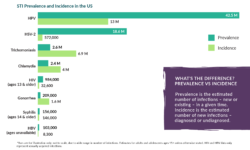Sexually Transmitted Infections Prevalence, Incidence, and Cost Estimates in the United States
CDC released updated STI prevalence, incidence, and cost estimates as part of a special issue in the journal Sexually Transmitted Diseases

CDC released updated STI prevalence, incidence, and cost estimates as part of a special issue in the journal Sexually Transmitted Diseases. The new estimates provide the clearest picture to date of how common and costly STIs are in the United States. They also serve as a reminder that proven STI prevention– at all levels – is a cornerstone of protecting America’s health, economic security, and wellness.
A CDC analysis provides the clearest picture to date of STIs in the United States. CDC estimates indicate about 20 percent of the U.S. population – approximately one in five people in the U.S. – had an STI on any given day in 2018, and STIs acquired that year will cost the American healthcare system nearly $16 billion in healthcare costs alone.
The analysis included eight common STIs: chlamydia, gonorrhea, hepatitis B virus (HBV), herpes simplex virus type 2 (HSV-2), human immunodeficiency virus (HIV), human papillomavirus (HPV), syphilis, and trichomoniasis. Chlamydia, trichomoniasis, genital herpes, and HPV accounted for 98% of all prevalent STIs and 93% of all new STIs in 2018.
Given the serious health consequences of untreated STIs, and that many infections go undetected and unreported to CDC, these estimates are critical to better understanding the vast scope of the STI epidemic and who is most affected. (At A Glance: STI Prevalence, Incidence, and Cost Estimates in the United States)
View the STD Incidence/Prevalence and Cost Estimates in STD Journal
Quick Links from CDC
- At A Glance: STI Prevalence, Incidence, and Cost Estimates in the United States
- Social Media Materials: Messages and Graphics to Help Spread the Word
- Dear Colleague Letterpdf icon: Announcement about Updated STI Prevalence, Incidence, and Cost Estimates
- Press Release: CDC Estimates 1 in 5 People in the U.S. Have a Sexually Transmitted Infection
- Media Fact Sheetpdf icon: Incidence, Prevalence, and Cost of Sexually Transmitted Infections in the United States
- Success Storypdf icon: Calculating the Burden of STIs in the US: New CDC Research Streamlines Data Analysis
